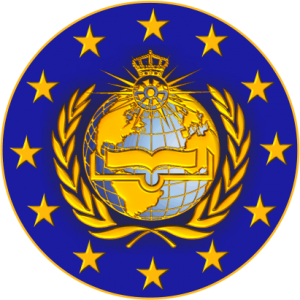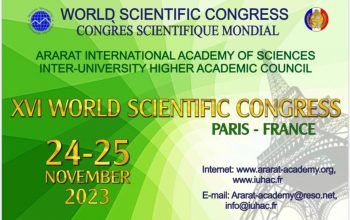
International Intellectual property Institute
International University of Fundamental Studies
International Higher Academic Council
International Patent for invention
GENERIC EQUIVALENT OF MONEY
№ …../40.004
Inventor: Alexander A. Startsev, Philosophy Grand-Doctor, Professor in Ecodynamics and Geopolitics (RU)
Applicant: Alexander A. Startsev, Philosophy Grand-Doctor, Professor in Ecodynamics and Geopolitics (RU)
Application No. …./40.004 (Protection of Peace, Safety of State)
1.Introduction
The scientific knowledge and practical experience gained so far indicate that the mankind is facing a critical period of its existence on Earth. The civilization has come across several unprecedented global challenges, particularly including evident signs of coming worldwide environmental disaster that determines the necessity in the adoption of a new strategy of survival and further development without any right to mistake since a wrong way can lead to terrible consequences. A strategic approach to overcoming the global crisis should be based to the fundamental science and universal laws of nature.
According to recent scientific data (theory of biotic regulation) natural ecosystems act as structural units of the biosphere similar to natural landscapes and their constituent biogeocenosies representing primary impartible parts of ecosystems. The Life represented in biota (all plants and animals, with 99% of this system comprising microorganisms and fungi) builds the environment and adjusts it favor of biota by maintaining a dynamic sustainability of the environment, including the average annual temperature on the planet surface about 15˚C convenient for Life [1]. Generally, biota is the natural basis of life sustainability in the biosphere, and the destruction of biota will leave only two stable states of environment, including day temperature about + 400˚C and night temperature about -100˚С [2].
Moreover, irrefutable conclusions and proofs obtained in 2005 (unfortunately, still little-known to scientific community) suggest that the amount and availability of fresh water, including rivers and terrestrial rainfall are determined by pristine forest ecosystems via a mechanism named a Forest biotic pump. Numerous experiments confirmed that in addition to the control of carbon dioxide content in the atmosphere, including the consumption of anthropogenic carbon, pristine forests act as a living pump for water transfer, providing the transition ashore of water evaporated from oceans followed by its precipitation as rain and snow. A possibility for water transfer from oceans to land is determined by physical properties of water vapor. The destruction (cutting and burning) of pristine forests and drying of forests prevents from terrestrial water evaporation, leading to the degradation of low atmosphere pressure zones, deterioration of moisture transfer from seashores inside the continent and complete termination of these processes in the course of desertification [3].
Nevertheless, instead of following UN appeals to the concentration of efforts and resources on addressing global environmental challenges and threats the civilization fell into a long and severe economic recession in autumn 2008. Since 2008 a total financial speculative market turnover grew from 500 trillion to more than 3.5 quadrillion USD (with the estimated overall worldwide material are only 150 trillion USD). These “hot money” can bring down the economy of all the countries and result in irreversible adverse effects to the environment causing threat to all the life in biosphere.
The only effective approach to survival and further development of the civilization is based on maintaining a human life friendly environment due to the preservation and recovery of pristine natural ecosystems providing a stabilizing effect proportionate to their total area. However, the existing financial and economic system cannot support the relating efforts.
Addressing these goals requires radical changes in the system of values in the society, production and consumption paradigms based on the “Green Economy” model in combination with a search for sustainable sources of financial support and development of a new investment mechanism. The only possible approach on the financial level is based on the application of national currencies and development of regional emission currencies, particularly in the Eurasian region. The organization of such emission centers should promote the transfer of money supply to a modernized “green” economy by all means without any support of a free capital outflow even in the course of possible financial panic periods. These measures comprise one of the primary goals of national governments.
2.Priority
The invention priority is November 24, 2015, published in [4], the manuscript received by the editorials on November 24, 2015.
- Description of the invention
The introduction of a generic equivalent of money is suggested to provide an efficient ruble-based financial system based on the national emission currency as an effective source of investments into an environment friendly, socially oriented an innovative economy.
The generic equivalent of money should meet the following requirements:
- It shall possess a worldwide accepted vital value for humans on both national and global levels.
- It shall adhere certain limitations on the amount that cannot increase in an accelerated way, e.g. as a result of the development of new technologies.
- It shall not be involved in an economic turnover and production of various goods and services.
- It shall be involved in stock speculations, stock market securities and their derivatives.
- There shall be no ability for its transfer through national boundaries.
The only object meeting the above requirements is the natural environment (pristine and almost intact ecosystems responsible for life sustainability on Earth, including forests, wetlands, rivers and lakes, fertile soils and generally all the biodiversity). Presently the natural environment is distributed very irregularly, with its components permanently decreasing under the destructive impact of the technosphere. The value of pristine and almost intact ecosystems in respect of maintaining life sustainability on Earth is unimaginable. No other money equivalents (gold, energy units, bitcoins and other crypto-currencies) do not meet the considered criteria and cannot support maintaining the nature, survival and further development of the civilization.
Thus, the system of pristine an almost intact natural ecosystems can be considered as a generic equivalent of money for providing an efficient ruble-based system based on the national emission currency as an effective investment source for the environment friendly, socially oriented and innovative economy. The relating conventional non-cash currency unit is an environmental ruble.
The suggested invention can provide the development of a governmental system for the mobilization of resources towards the investment into the priority projects in the fields of environment protection, healthy lifestyle, development of science and education, training and sports, culture and arts, disclosure of human creativity.
The environmental ruble is not a replacement but an addition to the national currency for internal investments. The new investment system should be supported by a sufficient amount of money. Particularly, up to 15 trillion of rubles (difference between the total amount of money required for the adequate functioning of economy at the existing GDP and the overall existing money determined by turnover rate) can be involved through the remonetization of economy . Presently this kind of money supply is about 40% of the necessary level. Furthermore, for the periods of high costs for oil Russia accumulated sufficient reserves. In the beginning of 2016 Russian international reserves comprised $368 billion and now this value has increased to $379 billion. Therefore, at least $200 billion possessed by the government can be invested for national development straight away without any risk of ruble weakening. Gold reserves presently triple exceed the expected import level for 2016. Enterprises provided sufficient fixed assets and the people accumulated more than $250 billion n banking accounts (and probably similar amounts in cash). An adequate governmental policy can afford the involvement of these resources for such socially valuable targets as environment protection, health improvement and development of the society.
Practical meaning of the invention: at the current phase of social development the application of environmental ruble can be tested on clearing settlements between EAEC countries (similar to the system earlier applied in CMEA) with the emission center located in Russia as the country maintaining a unique natural capital (63% of natural ecosystems remaining in the pristine state or only slightly deteriorated by anthropogenic impacts and emergency situations) muck larger compared with Republics of Belarus, Kazakhstan and Kyrgyzstan.
Environmental ruble is a merely internal currency of EAEC countries and should not be involved in turnover with other countries and on the worldwide level. The corresponding bank should be established to invest this currency only in non-cash funds for the development of real economy, innovative development and import substitution. Environmental rubles shall not be used for currency buying and outflow abroad since they shall be only applied for specified purposes according to the corresponding legislation.
For BRICS and SCO countries another conventional environmental currency unit enviro (from the word “environment”) can be also suggested and supported by Russian and Brazil as the key global holders of the natural capital possessing more than 60% of worldwide pristine and almost intact ecosystems as well as about 70% of worldwide fresh water resources. Particularly, recent research data clearly indicate that Russian pristine forests are responsible for fresh water supply for all the Western Europe, Central Asia and China due to the Forest biotic pump system. This is an extremely high contribution into maintaining an appropriate life quality. Russian “forest pump” attracts a moisture-bearing air evaporated from oceans to the continent as clouds of fresh water subsequently feeding land, rivers and lakes by rains and snow. For this reason a 7000 km long boreal forest layer is of utmost importance for Eurasian people and needs an urgent effective protection and support for sustainable development.
Literature:
- Gorshkov V.G., Gorshkov V.V., Makarieva A.M. (2000) Biotic Regulation of the Environment: Key Issue of Global Change. Springer-Praxis Series in Environmental Sciences, Springer, London, 367 pp.
- Gorshkov V.G., Gorshkov V.V., Makarieva A.M. (2002). On biotic regulation and the perspectives for life’s persistence http://www.bioticregulation.ru/life/life2_r-2.php
- Gorshkov V.G., Makarieva A.M. (2006). Biotic pump of atmospheric moisture, its links to global atmospheric circulation and implications for conservation of the terrestrial water cycle. http://www.bioticregulation.ru/ab.php?id=bppr&lang=ru
- Startsev A.A. (2015). Be wiser to survive. The contours of the new model being. http://www.zavtra.ru


